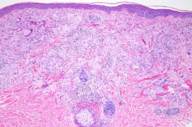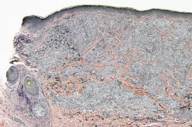Actinic granuloma
Published Web Location
https://doi.org/10.5070/D3440579jfMain Content
Actinic granuloma
Jennifer A Stein MD PhD, Bill Fangman MD, Bruce Strober MD PhD
Dermatology Online Journal 13 (1): 19
New York University Department of DermatologyAbstract
A 45-year-old man presented with a 3-year history of asymptomatic, annular, erythematous plaques on the face and neck. Histopathologic examination showed sarcoidal granulomas with an associated mixed-cell infiltrate, loss of elastic fibers, and no increase in mucin. These findings were consistent with a diagnosis of actinic granuloma, which is an uncommon, idiopathic disease that is characterized by granuloma annulare-like plaques on sun-exposed areas.
Clinical synopsis
 |
| Figure 1 |
|---|
A 45-year-old man presented to the New York University Dermatologic Associates with a 3-year history of asymptomatic, persistent, annular plaques on the face and neck. Previous biopsy specimens had been interpreted as granuloma annulare and possible cutaneous sarcoidosis. Prior treatments included a variety of topical glucocorticoids and several short courses of prednisone (each less than 10 days). No treatment demonstrated benefit. The patient denied other medical problems and was not taking any medications. A review of systems was negative. A skin biopsy was performed, and the patient was asked to wear sunscreen (SPF = 30) daily.
Several, erythematous, annular plaques without scale were present on the forehead, cheek, and neck.
 |  |
| Figure 2 | Figure 3 |
|---|
Histopathology reveals granulomatous inflammation composed of epithelioid mono- and multinucleated histiocytes within the dermis. Many of these histiocytes have greater than ten nuclei and have fragments of elastic fibers within their cytoplasm. Necrobiosis of collagen is not identified. A Verhoeff-van Gieson stain highlights the loss of elastic fibers centrally and the presence of elastic fibers within the cytoplasm of histiocytes at the periphery.
Comment
Actinic granuloma, or annular elastolytic giant-cell granuloma, is an uncommon, idiopathic disorder of middle-aged adults, which occurs more commonly in women than in men. It is characterized by annular plaques that are similar to those observed in granuloma annulare but that specifically appear in sun-exposed skin. Because actinic granuloma is so similar to granuloma annulare, it is sometimes considered to be a type of granuloma annulare [1, 2].
The annular plaques of actinic granuloma can have atrophic or hypopigmented centers and elevated erythematous borders. The lesions are histopathologically similar to granuloma annulare and show non-palisading granulomas with foreign-body-type, multinucleated giant cells as well as lymphocytes and histiocytes. The lymphocytes are predominantly CD4 positive. The histopathologic criteria that distinguish actinic granuloma from granuloma annulare are the absence of elastic fibers in the center of the actinic granuloma lesions and the presence of elastic fibers within giant cells. Additionally, there should not be any increase in mucin, which might be expected in granuloma annulare.
Necrobiosis lipoidica diabeticorum can histopathologically resemble actinic granuloma, which differs in its lack of altered collagen. Actinic granuloma can also resemble sarcoid as was noted in our patient, who actually had a prior biopsy specimen that was interpreted as possible sarcoid. Actinic granuloma should have more associated inflammation than is observed in sarcoid, and this criteria was used to make the diagnosis in this patient [3].
The pathogenesis of actinic granuloma is controversial. While some believe that the destruction of elastic fibers triggers an inflammatory response that causes granulomas [1], others argue that elastic fiber destruction is caused by the granulomatous inflammation itself [4].
The postulated mechanism behind the actinic damage hypothesis is that solar-damaged elastic fibers are weakly antigenic and result in a cell-mediated immune response with a predominance of CD4 lymphocytes. This immune response is thought to be an attempt to repair the actinically damaged skin but results in granulomatous inflammation instead. Support for this hypothesis comes from the sun-exposed distribution of the disease, the presence of CD4 cells, and the presence of giant cells that appear to be ingesting the elastic fibers [1, 5]. This evidence, however, is merely correlative and does not address whether the granulomas are the consequence of or are actually the cause of the damaged elastic fibers. There has been no direct demonstration that actinic damage can induce granuloma formation, and one case report described an inability to provoke lesions with a 4-day photochallenge in a patient with pre-existing actinic granuloma [6]. Additionally, it has been noted that elastic fiber destruction can be observed in granuloma annulare and necrobiosis lipoidica diabeticorum, which demonstrates that elastin destruction may be secondary to granulomatous inflammation [7].
Treatment of actinic granuloma is difficult. The lesions tend to persist and respond little, if at all, to topical or intralesional glucocorticoids. There is anecdotal evidence for beneficial responses to acitretin, isotretinoin, cyclosporin, chloroquine, pentoxifylline, cryotherapy, PUVA photochemotherapy, and methotrexate. Some patients experience spontaneous resolution of the lesions. Patients are generally advised to avoid sun exposure and to wear sunscreen to prevent development of new lesions, as was recommended in our patient [2, 8, 9].
References
1. O'Brien JP. Actinic granuloma: an annular connective tissue disorder affecting sun- and heat-damaged (elastotic) skin. Arch Dermatol 1975;111:4602. Howard A, White CR Jr. Non-infectious granulomas. In: Bolognia J et al, eds. Dermatology. London: Mosby, 2003: 1455
3. Al-Hoqail IA, et al. Actinic granuloma is a unique and distinct entity: a comparative study with granuloma annulare. Am J Dermatopathol 2002;24:209
4. Ragaz A, Ackerman AB. Is actinic granuloma a specific condition? Am J Dermatopathol 1979;1:43
5. O'Brien JP, Regan W. Actinically degenerate elastic tissue is the likely antigenic basis of actinic granuloma of the skin and of temporal arteritis. J Am Acad Dermatol 2000;42:148
6. Kiken DA, et al. A provocative case: phototesting does not reproduce the lesions of actinic granuloma. Photodermatol Photoimmunol Photomed 2002;18:315
7. Hanke CW, et al. Annular elastolytic giant cell granuloma: a clinicopathologic study of five cases and a review of similar entities. J Am Acad Dermatol 1979;1:413
8. Stefanaki C, et al. Actinic granuloma successfully treated with acitretin. Int J Dermatol 2005;44:163
9. Rubio FA, et al. Actinic granuloma and vitiligo treated with pentoxifylline. Int J Dermatol 1998;37:958
© 2007 Dermatology Online Journal

